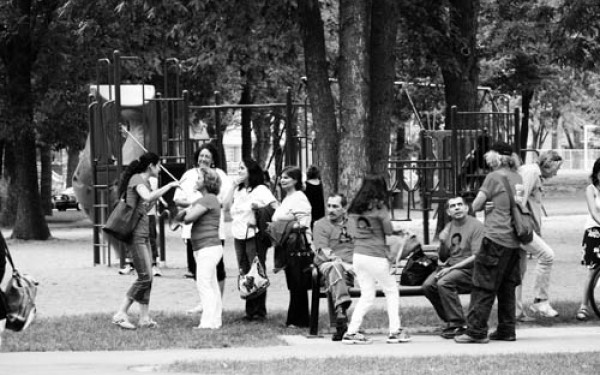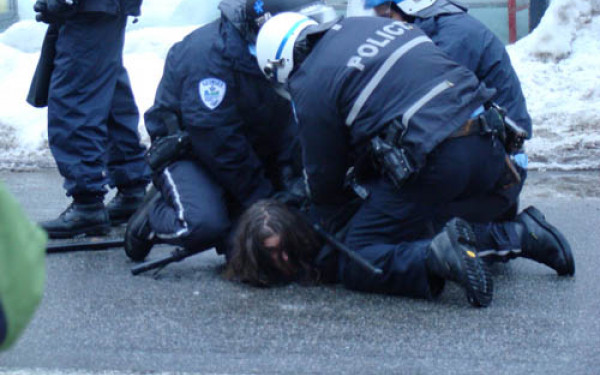The End of an Occupation?
Despite Evictions, Occupiers Party and Vow to Go On
In the end, Occupy Montreal didn’t go out with a flash bang, but with a bass line.
Exactly six weeks after the global Occupy phenomenon came to the city, Victoria Square was a place transformed, then transformed again.
Gone was the intricate maze of shelters and structures. Gone were the kitchen and library areas. And gone were many of the inhabitants of the tent city, kicked out by members of the Service policière de la Ville de Montréal on Nov. 25.
Still, despite the naked landscape of the square compared to the bustle and crowds that had been a mainstay for the past month and a half, on Saturday afternoon, a few hundred people came back to the site to discuss what they had been a part of, and where the movement will go now.
Unlike the violent end to the Occupy camps in New York, Oakland, and UC Davis, Montreal’s version didn’t end in clashes with the cops—instead, it ended with a concert. Local legends Bran Van 3000 performed a stripped-down set marked with the refrain, “Love is in the air.”
“I think it’s beautiful, that’s why I’m here,” said James di Salvio, Bran Van’s leader. “[It’s about] common sense, bringing it back to a bit of a balance.”
The Eviction
The “common sense” di Salvio spoke of seemed to be scarce just a day earlier, when the SPVM arrived with orders to clear out the site. The day before that, the Occupiers had been served eviction notices, though no deadline was given for them to leave by.
I managed to stop by the day the notices were served, just as Occupier Greg Adams got through joking with two SPVM moderators passing through the camp.
Though he declined to talk about their conversation, Adams spoke about the relationship between the police and the Occupiers in positive terms, growing emotional recounting an encounter he’d had with an SPVM supervisor who drove up to the camp.
“We thought, ‘What regulation are you gonna try and oppress onto us at this point?’
“He got out and donated two whole bags of clothing. He turned around, looked at us and said ‘Under the uniform, I’m human, and I’m with you, too. My wife supports you, my family thanks you. Good God, you guys are brave.’ It echoes through my head right now.”
It’s the kind of story you heard a lot. Occupier Ben Godin, who had been at the camp since Oct. 17, recalled getting upwards of four phone calls a day from the SPVM, just checking up on how everyone was doing.
“It was more than cordial, it was friendly,” he said. “We were assured all along by the police that they were giving positive reports internally to city officials. When it turned out that we got the eviction notice, take it as you will, but they told us that they were disappointed, that we had been betrayed.”
That kind of openness with the cops was on display a few weeks earlier when I went to the site for the first time. During a march through the downtown core, I consistently saw committee members and organizers exchanging kind words with the police escorting them.
So when police and city workers showed up on Friday morning and, according to some accounts, grew “aggressive” with the Occupiers and members of the press—a photographer for The Link was threatened with arrest if he did not vacate the area—it came as a surprise.
Godin was one of 16 people arrested during the eviction, though no charges were laid. He had tied himself in a human chain to the camp kitchen, which had come to represent something more than a mere food dispensary.
“The kitchen was a symbolic center to the Occupation,” he said. “Everyone went to the kitchen, and it was a symbol of support not just to the people who were working there, but to the homeless population that found a community with us.”
After being grabbed and having his arm twisted and a pressure point in his neck prodded, Godin was told not to come back while police were still at the site. Still, he feels that the atmosphere was not one of aggression, but of “people trying to do their job.”
“Aside from the two guys who removed me, who I felt were violent and painful, they were generally okay.”
What Now?
Today, the tents have been torn down, and the inhabitants have all gone back to wherever they came from. All that’s left is the question that’s been levied at the movement since the beginning: what’s next? What do you do when a protest predicated on the physical occupation of a location no longer physically occupies that space?
“That’s a good question,” said di Salvio. “Even in the middle of summer we were wondering what was going to happen in the winter. We’re human, and it gets very cold.”
Rather than look at the winter as a time for bonds to weaken, di Salvio, who had also paid a visit to New York City to check out Occupy Wall Street, thinks that breaking up the camp will result in different kinds of organization—digital and physical—that will lead to bigger things when the temperatures rise again in the spring.
Not surprisingly, he used an example from his own career.
“It’s almost like a tour: you go and reinforce and recharge to meet up again next summer.”
While much has been made of the Occupy movement’s lack of formal leadership and demands, Patrice Dauphin, a community activist from St. Michel who spoke at Saturday’s event, said that the eviction will ultimately make the structure stronger.
“When you have one leader, usually he’s going to bring his way of doing things. When there’s no leader, everybody is the leader. So it’s the people that are deciding where to go instead of [being led]. That’s what’s beautiful about direct democracy, is that we are the power.”
That sense of optimism seemed to be contagious. During Bran Van’s set, there was not a hint of sadness in the barely illuminated crowd. But even on the day when eviction notices were being handed out, members of the camp couldn’t help but look forward to the future.
“We’ve always been dealing with in-camp issues,” said Jamie Klinger, who has been in the camp since it began. “So let’s say we do leave the camp, we don’t have to deal with camp issues anymore.”
Klinger predicted two different possible outcomes. Either some of the most heavily invested people will get their own space, and try to keep the dialogue going from there, or, as he put it, “If we don’t have a space, then we’re everywhere. Then we’re several hundred people packed with all this information and all this energy spent trying to keep this camp alive, and it’s just going to go out and make Occupy live everywhere. It’s going to spread like wildfire.”
Back to Square One
Godin noted that even the activity in Victoria Square is not done. There are still plans for three weekly general assemblies at the downtown financial district space, as well as smaller ones for neighbourhoods that may host their own, smaller Occupations.
“They’re going to have their own meetings during the week, and then report back on Saturday,” he said. “The one central location is going to continue to exist. We’re not done. We won’t be there 24/7, but we’re still going to be meeting up there.”
While Klinger might be overambitious—he predicted a turnout of 10,000 to 15,000 for the rally and concert, though the actual turnout would be measured in the low to medium hundreds—it’s hard to fault him.
Maybe it’s that, more than many of the world’s Occupiers, this group is getting to leave—at least partly—on their own terms. Or maybe it’s a sense that the last six weeks will mean something, that it won’t be a quickly forgotten blip in time.
Before they were kicked out, Adams expressed both defiance and acceptance of the situation. While he wanted to stay, he seemed to know that time was short for the camp. All he wanted was one last party with his friends.
“Being down here, with a group of people who have been trying to make a statement… It has literally grown into a small family, a small village of joy. There’s a lot of people that just do not want to leave without really having one good last moment together.”
Though the ground looks strangely naked Saturday without the tents, the inhabitants faithfully returned. That night, with the help of a stage, a bass guitar, a drum set, some microphones and a few hundred people, they got their moment.

1_900_600_90.jpg)
_600_832_s.png)

_600_375_90_s_c1.jpg)


